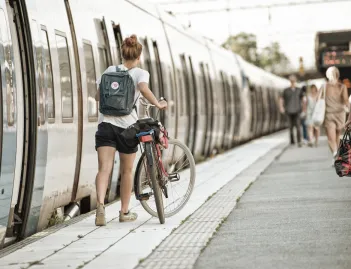15mC topic 1: Next steps for multimodal urban mobility, building on travel experience

Challenge description
Shifting to inclusive, sustainable and resilient mobility in European urban areas remains a significant challenge. While recent years have shown progress and frontrunner examples – particularly on sustainable mobility services and active travel – many questions persist on how to meet mobility needs of diverse city populations, while contributing to climate neutrality, affordability and attractiveness. In times of environmental urgency and financial constraints, innovative approaches and creative use of existing land-use, infrastructure and resources are essential. This topic focuses on strategies to improve sustainable transport options by integrating different modes and enhancing the perceived quality and experience of door-to-door travel. There is a growing need to explore how the daily travel experience can become more meaningful, enjoyable, and worthwhile – not only to increase the appeal of sustainable mobility, but to ensure that it is genuinely accessible and attractive to diverse users.
Scope
At the core of this topic stands urban public transportation and its connection to active and shared mobility to reduce dependency on private cars. It seeks ideas, concepts and supporting evidence to develop and enhance multimodal transport – integrating public transport (train, trams, bus, ferry etc.) with active mobility (walking, cycling, including safe bicycle parking) and shared services (cargo bikes, micromobility, car and ride sharing).
Proposals submitted in this topic should address key levers, gaps and barriers in connecting sustainable transport modes, including aspects of physical infrastructure, station or vehicle equipment, institutional procedures and (digital) tools that facilitate integration and information. They are invited to explore adapting mobility offers to evolving preferences and habits and develop strategies to engage communities, particularly vulnerable groups, as well as local businesses and housing associations in co-creating multimodal solutions. Transport mode integration, public space use and place-making should be considered together, focusing on quality of stay, health, safety and attractiveness as well as climate change adaptation, rethinking public transport stops and multimodal hubs as anchors points for urban mobility transitions.
This topic encourages proposals that build on the concept of worthwhile travel time, improving the overall door-to-door travel experience and working towards an integrated understanding of mobility modes from the perspectives of transport users themselves (including commuters, caregivers, students and school children, older adults, and those with limited mobility). One central aspect of this concept are travel activities, the ability to do something more than just travelling (e.g. to read a book, exercise, rest or enjoy the view). Understanding these additional desired activities and potential positive outcomes is part of the challenge of uncovering what worthwhile travel time means for different groups. Proposals are invited to capture the diverse experiences of different groups and their perception on selecting, accessing and using a transport mode, as well as exploring their specific needs (e.g. of students and school children, older adults or people with limited mobility) or addressing the complexity of connected trips (e.g. of caregivers or commuters) to improve transport offers.
Project proposals submitted under this topic should address one or several of the following issues:
- Which innovative methods (e.g. travel diaries, participatory mapping, passive sensing) can be used to collect nuanced, real-world data on people’s door-to-door travel experiences across modes and contexts?
- How can diverse needs and perspectives of transport users on worthwhile travel experience from door-to-door be best leveraged for and integrated into planning high-quality, multimodal urban mobility systems?
- Which strategies, policies and approaches support efficient integration of public transport, active and shared mobility, and last-mile solutions? How can infrastructural, legal, and digital barriers be overcome?
- How can multimodal integration be best achieved in different varying contexts and cities of different sizes, paying special attention to “smooth” transfers between modes (e.g. efficiency, safety, bicycle parking etc.)?
- How can needs and perspectives of local communities, business and associations be integrated into co-designing and implementing neighbourhood-oriented multimodal solutions?
- How can mobility hubs and transport stops increase to local attractiveness, climate adaptation, and public space quality and serve as neighbourhood anchors?
Expected outputs and outcomes
Rather than focusing on isolated technical solutions, projects are expected to approach this topic through systems thinking, place-based and human-driven strategies related to this topic. Project outcomes should be both impact-oriented and process-driven, aiming to be as concrete and user-centred as possible. Projects should clearly define their expected outputs in relation to the chosen question. Expected outputs include, but are not limited to:
- Concepts and instruments to collect data on travel experience and satisfaction facilitating multimodal mobility in urban areas.
- Analysis and design frameworks to incorporate diverse user needs into multimodal mobility planning, based on door-to-door worthwhile travel experience.
- Strategies, approaches and recommendations to implement integrated multimodal urban transport systems.
- Transferable case studies demonstrating implementation of high-quality, door-to-door multimodal services in various contexts and city sizes.
- Approaches to participatory design and co-creation of neighbourhood-oriented mobility solutions.
- Place-making strategies connected to local multimodal hubs and transport stops.